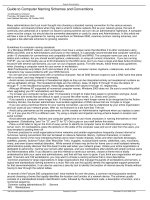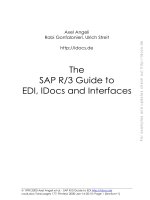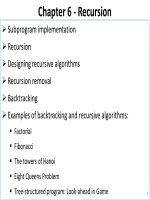Guide to Computer forensics and investigations Chapter 6 Current digital forensics tools
Bạn đang xem bản rút gọn của tài liệu. Xem và tải ngay bản đầy đủ của tài liệu tại đây (519.64 KB, 54 trang )
Guide to Computer Forensics
and Investigations
Fifth Edition
Chapter 6
Current Digital Forensics Tools
Objectives
• Explain how to evaluate needs for digital forensics
tools
• Describe available digital forensics software tools
• List some considerations for digital forensics
hardware tools
• Describe methods for validating and testing
forensics tools
Guide to Computer Forensics and Investigations, Fifth Edition
© Cengage Learning 2015
2
Evaluating Digital Forensics Tool
Needs
• Consider open-source tools; the best value for as
many features as possible
• Questions to ask when evaluating tools:
– On which OS does the forensics tool run
– What file systems can the tool analyze?
– Can a scripting language be used with the tool to
automate repetitive functions?
– Does it have automated features?
– What is the vendor’s reputation for providing
support?
Guide to Computer Forensics and Investigations, Fifth Edition
© Cengage Learning 2015
3
Types of Digital Forensics Tools
• Hardware forensic tools
– Range from single-purpose components to complete
computer systems and servers
• Software forensic tools
– Types
• Command-line applications
• GUI applications
– Commonly used to copy data from a suspect’s disk
drive to an image file
Guide to Computer Forensics and Investigations, Fifth Edition
© Cengage Learning 2015
4
Tasks Performed by Digital Forensics
Tools
• Follow guidelines set up by NIST’s Computer
Forensics Tool Testing (CFTT) program
• ISO standard 27037 states: Digital Evidence First
Responders (DEFRs) should use validated tools
• Five major categories:
–
–
–
–
–
Acquisition
Validation and verification
Extraction
Reconstruction
Reporting
Guide to Computer Forensics and Investigations, Fifth Edition
© Cengage Learning 2015
5
Tasks Performed by Digital Forensics
Tools
• Acquisition
– Making a copy of the original drive
• Acquisition subfunctions:
–
–
–
–
–
–
Physical data copy
Logical data copy
Data acquisition format
Command-line acquisition
GUI acquisition
Remote, live, and memory acquisitions
Guide to Computer Forensics and Investigations, Fifth Edition
© Cengage Learning 2015
6
Tasks Performed by Digital Forensics
Tools
• Acquisition (cont’d)
– Two types of data-copying methods are used in
software acquisitions:
• Physical copying of the entire drive
• Logical copying of a disk partition
– The formats for disk acquisitions vary
• From raw data to vendor-specific proprietary
– You can view the contents of a raw image file with
any hexadecimal editor
Guide to Computer Forensics and Investigations, Fifth Edition
© Cengage Learning 2015
7
Tasks Performed by Digital Forensics
Tools
Guide to Computer Forensics and Investigations, Fifth Edition
© Cengage Learning 2015
8
Tasks Performed by Digital Forensics
Tools
• Acquisition (cont’d)
– Creating smaller segmented files is a typical feature
in vendor acquisition tools
– Remote acquisition of files is common in larger
organizations
• Popular tools, such as AccessData and EnCase, can
do remote acquisitions of forensics drive images on a
network
Guide to Computer Forensics and Investigations, Fifth Edition
© Cengage Learning 2015
9
Tasks Performed by Digital Forensics
Tools
• Validation and Verification
– Validation
• A way to confirm that a tool is functioning as intended
– Verification
• Proves that two sets of data are identical by
calculating hash values or using another similar
method
• A related process is filtering, which involves sorting
and searching through investigation findings to
separate good data and suspicious data
Guide to Computer Forensics and Investigations, Fifth Edition
© Cengage Learning 2015
10
Tasks Performed by Digital Forensics
Tools
• Validation and verification (cont’d)
– Subfunctions
• Hashing
– CRC-32, MD5, SHA-1 (Secure Hash Algorithms)
• Filtering
– Based on hash value sets
• Analyzing file headers
– Discriminate files based on their types
– National Software Reference Library (NSRL) has
compiled a list of known file hashes
• For a variety of OSs, applications, and images
Guide to Computer Forensics and Investigations, Fifth Edition
© Cengage Learning 2015
11
Tasks Performed by Digital Forensics
Tools
Guide to Computer Forensics and Investigations, Fifth Edition
© Cengage Learning 2015
12
Tasks Performed by Digital Forensics
Tools
• Validation and discrimination (cont’d)
– Many computer forensics programs include a list of
common header values
• With this information, you can see whether a file
extension is incorrect for the file type
– Most forensics tools can identify header values
Guide to Computer Forensics and Investigations, Fifth Edition
© Cengage Learning 2015
13
Tasks Performed by Digital Forensics
Tools
Guide to Computer Forensics and Investigations, Fifth Edition
© Cengage Learning 2015
14
Tasks Performed by Digital Forensics
Tools
Guide to Computer Forensics and Investigations, Fifth Edition
© Cengage Learning 2015
15
Tasks Performed by Digital Forensics
Tools
Guide to Computer Forensics and Investigations, Fifth Edition
© Cengage Learning 2015
16
Tasks Performed by Digital Forensics
Tools
• Extraction
– Recovery task in a digital investigation
– Most challenging of all tasks to master
– Recovering data is the first step in analyzing an
investigation’s data
Guide to Computer Forensics and Investigations, Fifth Edition
© Cengage Learning 2015
17
Tasks Performed by Digital Forensics
Tools
• Extraction (cont’d)
– Subfunctions of extraction
•
•
•
•
•
•
Data viewing
Keyword searching
Decompressing or uncompressing
Carving
Decrypting
Bookmarking or tagging
– Keyword search speeds up analysis for investigators
Guide to Computer Forensics and Investigations, Fifth Edition
© Cengage Learning 2015
18
Tasks Performed by Digital Forensics
Tools
Guide to Computer Forensics and Investigations, Fifth Edition
© Cengage Learning 2015
19
Tasks Performed by Digital Forensics
Tools
Guide to Computer Forensics and Investigations, Fifth Edition
© Cengage Learning 2015
20
Tasks Performed by Digital Forensics
Tools
• Extraction (cont’d)
– From an investigation perspective, encrypted files
and systems are a problem
– Many password recovery tools have a feature for
generating potential password lists
• For a password dictionary attack
– If a password dictionary attack fails, you can run a
brute-force attack
Guide to Computer Forensics and Investigations, Fifth Edition
© Cengage Learning 2015
21
Tasks Performed by Digital Forensics
Tools
• Reconstruction
– Re-create a suspect drive to show what happened
during a crime or an incident
– Methods of reconstruction
•
•
•
•
•
Disk-to-disk copy
Partition-to-partition copy
Image-to-disk copy
Image-to-partition copy
Rebuilding files from data runs and carving
Guide to Computer Forensics and Investigations, Fifth Edition
© Cengage Learning 2015
22
Tasks Performed by Digital Forensics
Tools
• Reconstruction (cont’d)
– To re-create an image of a suspect drive
• Copy an image to another location, such as a
partition, a physical disk, or a virtual machine
• Simplest method is to use a tool that makes a direct
disk-to-image copy
– Examples of disk-to-image copy tools:
• Linux dd command
• ProDiscover
• Voom Technologies Shadow Drive
Guide to Computer Forensics and Investigations, Fifth Edition
© Cengage Learning 2015
23
Tasks Performed by Digital Forensics
Tools
• Reporting
– To perform a forensics disk analysis and
examination, you need to create a report
– Subfunctions of reporting
• Bookmarking or tagging
• Log reports
• Report generator
– Use this information when producing a final report
for your investigation
Guide to Computer Forensics and Investigations, Fifth Edition
© Cengage Learning 2015
24
Tool Comparisons
Guide to Computer Forensics and Investigations, Fifth Edition
© Cengage Learning 2015
25









